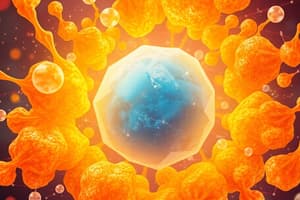Podcast
Questions and Answers
What is the primary function of hyaluronic acid in the body?
What is the primary function of hyaluronic acid in the body?
- Lubrication in synovial fluid (correct)
- Protein synthesis
- Hormone regulation
- Energy storage
What role do oligosaccharides play in glycolipids?
What role do oligosaccharides play in glycolipids?
- They serve as signaling molecules only.
- They are bound covalently to lipids. (correct)
- They are not found in glycolipids.
- They are involved in energy storage.
Which oligosaccharide complex is responsible for determining blood groups?
Which oligosaccharide complex is responsible for determining blood groups?
- Starch.
- Gangliosides. (correct)
- Lipopolysaccharides.
- Glycogen.
What are lipopolysaccharides primarily associated with?
What are lipopolysaccharides primarily associated with?
What is a consequence of bacterial endotoxins on the human body?
What is a consequence of bacterial endotoxins on the human body?
What is the major component of cartilage that provides strength?
What is the major component of cartilage that provides strength?
What type of structure does keratan sulfate possess?
What type of structure does keratan sulfate possess?
How are proteoglycans primarily formed?
How are proteoglycans primarily formed?
Which of the following is a characteristic of heparin?
Which of the following is a characteristic of heparin?
Which type of molecules serve as the main target of antibodies against gram-negative bacteria?
Which type of molecules serve as the main target of antibodies against gram-negative bacteria?
What type of bond is used to link glucosaminoglycans to the protein core in proteoglycans?
What type of bond is used to link glucosaminoglycans to the protein core in proteoglycans?
What condition is primarily associated with defects in hyaluronic acid?
What condition is primarily associated with defects in hyaluronic acid?
What are mucopolysaccharidoses primarily a result of?
What are mucopolysaccharidoses primarily a result of?
Which disaccharide is formed from glucose and fructose?
Which disaccharide is formed from glucose and fructose?
What type of bond links the monosaccharides in a disaccharide?
What type of bond links the monosaccharides in a disaccharide?
Which polysaccharide is the main storage form in animals?
Which polysaccharide is the main storage form in animals?
Which type of polysaccharide is cellulose classified as?
Which type of polysaccharide is cellulose classified as?
What characteristic makes sucrose a non-reducing sugar?
What characteristic makes sucrose a non-reducing sugar?
What is the function of lactulose in the body?
What is the function of lactulose in the body?
What structural feature distinguishes amylose from amylopectin?
What structural feature distinguishes amylose from amylopectin?
Which of the following is a non-sulfated glucosaminoglycan?
Which of the following is a non-sulfated glucosaminoglycan?
Flashcards are hidden until you start studying
Study Notes
Disaccharides
- Two monosaccharides joined together by a glycosidic bond
- Yield two simple sugars upon hydrolysis
- Types: Maltose, Lactose, Sucrose, Lactulose
Maltose
- Glucose + glucose
- Malt sugar
Lactose
- Glucose + galactose
- Main carbohydrate in milk
Sucrose
- Glucose + fructose
- Does not contain a free carbonyl carbon, making it non-reducing
Lactulose
- β-galactose + fructose
- Joined by a β-1-4 glycosidic bond between C1 of Galactose and C4 of Fructose
- Importance:
- Laxative: Not absorbable from the intestine, creates bulk in the stool due to its osmotic effect, treats constipation
- Beneficial for patients with liver disease: Prevents intestinal bacteria from producing ammonia, which diseased livers cannot process
Polysaccharides
- Complex carbohydrates formed by many monosaccharide units linked together
- Classified as:
- Homopolysaccharides: Composed of one type of monosaccharide (e.g., starch, glycogen, cellulose)
- Heteropolysaccharides: Composed of different types of monosaccharides (e.g., hyaluronic acid, heparin)
Homopolysaccharides
- Starch: Major storage form of carbohydrates in plants.
- Structure: Composed of two chains:
- Amylose: Straight chain of glucose units linked by α-1-4 glycosidic bonds
- Amylopectin: Branched chain of glucose units linked by α-1-4 glycosidic bonds and α-1-6 glycosidic bonds at branching points
- Structure: Composed of two chains:
- Glycogen: Major storage form of carbohydrates in animals.
- Structure: Branched polymer of glucose units linked by α-1-4 glycosidic bonds and α-1-6 glycosidic bonds at branching points
- Cellulose: Forms the wall of plant cells.
- Structure: Composed of repeated glucose units linked together by β-1-4 glycosidic bonds.
- Significance: Not digested in the human body due to the lack of β-glycosidase enzymes, prevents constipation, forms bulk of stool
Heteropolysaccharides (Complex Polysaccharides)
- Nonsulfated glucosaminoglycans (GAGs) or mucopolysaccharides
- Hyaluronic acid: Composed of alternating residues of D-glucuronic acid and N-acetylglucosamine.
- Functions:
- Forms a clear, highly viscous solution that acts as a lubricant in synovial fluid of joints
- Forms the vitreous humor, which fills the eyeball
- Forms the extracellular matrix of cartilage and tendons
- Functions:
- Hyaluronic acid Defect: Can lead to osteoarthritis
- Hyaluronic acid: Composed of alternating residues of D-glucuronic acid and N-acetylglucosamine.
- Sulfated Glucosaminoglycans
- Heparin
- Heparan sulfate
- Keratan sulfate
- Chondroitin sulfate
- Dermatan sulfate
Heparin
- An anticoagulant found in mast cells
- Structure: Repeated disaccharide units of glucosamine-so4 + glucuronic acid (variable) or iduronic acid
Heparan Sulfate
- Similar structure to Heparin, but more acetylated and less sulfated
Keratan Sulfate
- Present in:
- Type I: Cornea
- Type II: Cartilage
- Structure: Repeated disaccharide units of N-acetylglucosamine-so4 + galactose
Mucopolysaccharidosis
- Autosomal recessive inherited diseases caused by lysosomal enzyme defects responsible for metabolizing membrane-associated glucosaminoglycans
- Excess accumulation of glucosaminoglycans in lysosomes of affected cells
- Consequences: Skeletal deformities, mental retardation, and early death
Glycoconjugates
- Carbohydrates covalently bound to:
- Proteins (Proteoglycans & Glycoproteins)
- Lipids (Glycolipids “Lipopolysaccharides”)
Proteoglycans
- Macromolecules containing glucosaminoglycan chains covalently bound to a membrane or secreted protein
- Glycan (CHO) part makes up the larger portion
- GAGs are composed of amino sugars and uronic acids
- Major component of cartilage, contributing to its strength
- Provide points of adhesion, recognition, and information transfer between cells or between cells and the extracellular matrix
- Glucosaminoglycans attach to the protein core via a trisaccharide linker composed of:
- Galactose
- Galactose
- Xylose
- S (sulfate)
- The protein core is coupled to the trisaccharide linker via its serine residue by an O-glycosidic bond.
Glycoproteins
- Oligosaccharides are smaller than the proteins
- Present on cell surfaces (cell membranes) or extracellularly (plasma proteins, except albumin)
Glycolipids and Lipopolysaccharides
- Oligosaccharides are covalently bound to lipids
- Gangliosides: Membrane lipids in eukaryotic cells, complexed with oligosaccharides, play a role in determining blood groups
- Lipopolysaccharides: Glycolipids found on the outer surface of bacterial cell walls in gram-negative bacteria
- Major target of antibodies produced by the immune system against these bacteria
- Some lipopolysaccharides are toxic to humans and are called bacterial endotoxins
- Endotoxins cause:
- Lowering blood pressure
- Toxic shock accompanying gram-negative bacterial infections
Studying That Suits You
Use AI to generate personalized quizzes and flashcards to suit your learning preferences.




